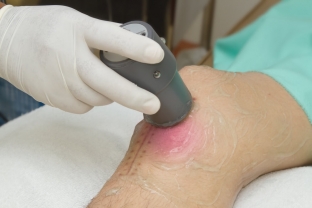It is important to start treatment of synovitis as soon as the diagnosis is established, because acute and chronic synovitis have a high likelihood of complications. Complications develop against the background of infection of the effusion in the joint cavity. When the process spreads beyond the synovial membrane, the process covers the fibrous membrane with the development of purulent arthritis. Against the background of arthritis, in the absence of adequate treatment, soft tissue phlegmon develops, or periarthritis. The most severe complications of infectious synovitis are panarthritis and sepsis. What is the treatment for synovitis?
Diagnostic procedures required before treatment of synovitis
Chronic aseptic synovitis can also have complications. Chronic synovitis is accompanied by a gradual increase in joint volume, since the secret produced in large quantities does not have time to be absorbed back into the synovial membrane. Against this background, hydroarthrosis (dropsy of the joint) develops. In such a joint, the ligaments weaken, and the joint becomes "loose", which contributes to frequent dislocations and subluxations.
The main step in the diagnosis of joint pathology, in addition to examination and X-ray examination, is a diagnostic puncture of the joint fluid.
Joint puncture before synovitis treatment allows:
- identify and determine the cause of synovitis;
- assess the condition of the vessels of the synovial membrane;
- determine the concentration of hyaluronic acid;
- set the degree of fluid viscosity and enzyme activity.
Bacteriological examination of punctate allows to determine the nature of the liquid, makes it possible to determine the sensitivity to antibiotics in infectious synovitis. If it is necessary to clarify the diagnosis and before starting the treatment of synovitis, arthroscopy and a biopsy of the synovial membrane are performed.
What are the main aspects of synovitis treatment?
Outpatient treatment of synovitis is done when there is a small amount of fluid in the joint. Secondary synovitis is treated by specialists of a narrow profile – endocrinologists, hematologists, allergists. Acute aseptic synovitis of unspecified etiology is a direct indication for hospitalization.
In case of aseptic synovitis, when there is a small amount of fluid in the joint, immobilization of the joint, an elevated position and tight bandaging are prescribed. The patient is referred for UHF, UV - irradiation or electrophoresis with novocaine. In the presence of a large amount of fluid, in addition to the above procedures, a regular puncture of the joint is performed. In case of ineffectiveness, phonophoresis with hydrocortisone and electrophoresis with lidase or potassium iodide are prescribed.

Indications for the treatment of synovitis with the surgical method
The treatment of synovitis in the presence of purulent inflammation in it also requires immobilization and provision of an elevated position of the joint. With a mild course, a puncture of the joint is provided. A severe course requires flow-aspiration lavages of the joint cavities with antibiotic solutions. If necessary, an opening and drainage of the joint cavity is performed.
Chronic aseptic synovitis involves the treatment of the underlying disease with a puncture of the joint and ensuring its rest. It is advisable to prescribe NSAIDs, glucocorticosteroids, salicylates, rumalon and achimotrypsin. The patient is referred for physical therapy. If necessary, drugs are injected into the joint cavity. Chronic synovitis may be accompanied by the development of irreversible complications in the form of pathological changes in the synovial membrane. In this case, surgery is indicated with excision of the synovial membrane.
Prognosis for synovitis. When can synovitis treatment be ineffective?
The prognosis is favorable for aseptic and allergic synovitis. The purulent form of synovitis is often accompanied by the formation of joint contractures; in chronic synovitis, there is a high probability of developing joint stiffness. Even after synovectomy, relapses and contractures may develop. Therefore, at the first signs of pathological changes in the joint, the patient should be examined to determine the cause of the disease. Timely treatment of synovitis will prevent irreversible changes in the joint.









Add a comment